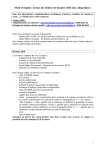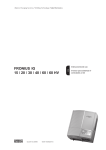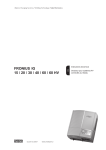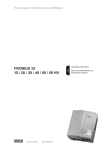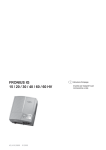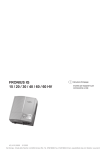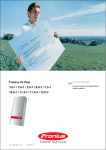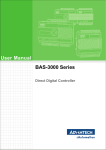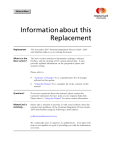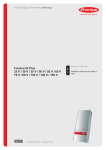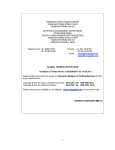Download FRONIUS IG 300, FRONIUS IG 400, FRONIUS IG 500
Transcript
co m ji. er en eo w w w .n FRONIUS IG 300 / 400 / 500 42,0410,1288 012006 GB Operating instructions Inverter for mains-connected photovoltaic systems ji. er en eo .n w w w co m Dear Reader Introduction Thank you for choosing Fronius - and congratulations on your new, technically highgrade Fronius product! This instruction manual will help you get to know your new machine. Read the manual carefully and you will soon be familiar with all the many great features of your new Fronius product. This really is the best way to get the most out of all the advantages that your machine has to offer. w w w .n eo en er ji. co m Please also take special note of the safety rules - and observe them! In this way, you will help to ensure more safety at your product location. And of course, if you treat your product carefully, this definitely helps to prolong its enduring quality and reliability - things which are both essential prerequisites for getting outstanding results. ud_fr_st_et_00493 012004 ji. er en eo .n w w w co m Safety rules DANGER! co m “DANGER!” indicates an imminently hazardous situation which, if not avoided, will result in death or serious injury. This signal word must be limited to the most extreme situations. This signal word is not used for hazards relating to property damage unless there is also a risk of personal injury appropriate to this level. WARNING! ji. “WARNING!” indicates a potentially hazardous situation which, if not avoided, could result in death or serious injury. This signal word is not used for hazards relating to property damage unless there is also a risk of personal injury appropriate to this level. CAUTION! en er “CAUTION!” indicates a potentially hazardous situation which, if not avoided, may result in minor or moderate injury. It may also be used to draw attention to unsafe practices that may cause damage to property. “NOTE!” indicates a situation which implies a risk of impaired results and damage to the equipment. eo NOTE! Important! “Important!” indicates practical hints and other particularly useful information. It is not a signal word for a harmful or dangerous situation. w .n Whenever you see any of the symbols shown above, pay close attention to the contents of the manual! w w General Remarks This equipment has been manufactured in accordance with the state of the art and general safety-engineering principles. Nevertheless, incorrect operation or misuse may still endanger - the life and well-being of the operator or of third parties, - the equipment and other tangible assets belonging to the owner/operator, - working efficiently with the equipment. All persons involved in any way with starting up, servicing and maintaining the equipment must - be suitably qualified - have good knowledge of dealing with electrical installations and - read this instruction manual thoroughly and follow the instructions to the letter. The instruction manual must be kept at the machine location at all times. In addition to the instruction manual, it is important to comply with both the generally applicable and local accident prevention and environmental protection regulations. I ud_fr_se_sv_00923 022005 General Remarks (continued) All the safety instructions and warning signs on the machine itself: - must be kept in a legible condition - must not be damaged - must not be removed - must not be covered, pasted or painted over For information about where the safety instructions and warning signs are located on the machine, please refer to the section of your machine’s instruction manual headed “General Remarks”. Any malfunctions which might impair machine safety must be remedied immediately before the machine is switched on. Utilisation for Intended Purpose Only co m Your safety is at stake! The machine may only be used for jobs as defined by the “intended purpose”. ji. Utilisation for any other purpose, or in any other manner, shall be deemed "not in accordance with the intended purpose". The manufacturer shall not be liable for any damage resulting from such improper use. en er Utilisation in accordance with the “intended purpose” also comprises - thorough reading of and compliance with all the instructions, safety instructions and warnings given in this manual - performing all stipulated inspection and servicing work - installation in accordance with the instruction manual eo Where appropriate, the following guidelines should also be applied: - regulations of the power supply company for input to the grid - information provided by the manufacturer of the solar modules Operation or storage of the machine outside the stipulated range is deemed “not in accordance with the intended use”. The manufacturer shall not be liable for any damage resulting therefrom. w w .n Ambient Conditions w Qualified Staff Please refer to the technical data in your instruction manual for accurate information about the permissible ambient conditions. The servicing information provided in this instruction manual is only intended for qualified staff. An electric shock can be fatal. Please do not carry out any activities other than those referred to in the documentation. This also applies even if you are suitably qualified. All cables and other leads must be firmly attached, undamaged, properly insulated and adequately dimensioned. Have loose connections, scorched, damaged or under-dimensioned cables and wires repaired immediately by an authorised specialist company. ud_fr_se_sv_00923 022005 II Qualified Staff (continued) Maintenance and repair may only be carried out by an authorised specialist company. There is no guarantee in the case of parts sourced from other suppliers that these parts have been designed and manufactured to cope with the stresses and safety requirements that will be placed on them. Use only original spare parts (this also applies to standard parts). Do not carry out any alterations, installations or modifications to the machine without first getting the manufacturer’s permission. co m Replace immediately any components that are not in perfect condition. Safety Precautions at the Machine Location Ensure when installing machines with cooling-air vents that the cooling air can flow freely through the air vents without obstruction. Only operate the machine with the degree of protection specified on the rating plate. Care must be taken during installation to ensure that there is no occurrence of electromagnetic interference with electrical and electronic equipment. Electrical Installations Electrical installations may only be executed in accordance with the relevant national and regional standards and specifications. eo en er ji. EMC Precautions Danger of damage to electronic components due to electrostatic discharge. Take appropriate protective measures when replacing and installing the components. w .n ESD Protective Measures w w Safety Precautions in Normal Operation Only operate the machine if all its protective features are fully functional. If any of the protective features are not fully functional, there is a danger to: - the life and well-being of the operator or other persons - the equipment and other tangible assets belonging to the owner/operator - working efficiently with the equipment. Have any safety features that are not fully functional repaired by an authorised specialist company before switching the machine on again. Never bypass or disable safety features. III ud_fr_se_sv_00923 022005 Equipment with the CE mark fulfils the basic requirements of the Guideline Governing Low-Voltage and Electromagnetic Compatibility. (More detailed information about this may be found in the Annex or in the section of your documentation headed “Technical Data”.) Disposal Do not dispose of this device with normal domestic waste! To comply with the European Directive 2002/96/EC on Waste Electrical and Electronic Equipment and its implementation as national law, electrical equipment that has reached the end of its life must be collected separately and returned to an approved recycling facility Any device that you no longer require must be returned to our agent, or find out about the approved collection and recycling facilities in your area. Ignoring this European Directive may have potentially adverse affects on the environment and your health! Data security The user is responsible for backing up data relating to changes made to factory settings. The manufacturer will not accept liability if personal settings are deleted. Copyright Copyright to this instruction manual remains the property of the manufacturer. en er ji. co m Safety markings w w w .n eo The text and illustrations are all technically correct at the time of going to print. The right to make modifications is reserved. The contents of the instruction manual shall not provide the basis for any claims whatever on the part of the purchaser. We should be most grateful for your comments if you have any suggestions for improvement, or can point out to us any mistakes which you may have found in the manual. ud_fr_se_sv_00923 022005 IV Contents Protection of personnel ................................................................................................................................. Safety ....................................................................................................................................................... Housing unit ............................................................................................................................................. Galvanic (electrical) isolation ................................................................................................................... Monitoring the mains network .................................................................................................................. Mains connection ..................................................................................................................................... Photovoltaic generator ............................................................................................................................. 3 3 3 3 3 4 4 co m Safety strategy .............................................................................................................................................. 5 Standards and regulations ....................................................................................................................... 5 Declaration of conformity ......................................................................................................................... 5 How a photovoltaic system works ................................................................................................................. General .................................................................................................................................................... Current is generated on the roof .............................................................................................................. Current is converted underneath the roof ................................................................................................ 6 6 6 7 er ji. The FRONIUS IG in the photovoltaic system ................................................................................................ 8 General .................................................................................................................................................... 8 Converting DC to AC current .................................................................................................................... 8 Fully automatic operational management ................................................................................................ 8 Voltage transformation and galvanic isolation .......................................................................................... 8 Monitoring the mains network .................................................................................................................. 9 Display function and data communication ................................................................................................ 9 Plus points: ............................................................................................................................................. 10 eo en The FRONIUS IG ......................................................................................................................................... 11 Mode of operation ................................................................................................................................... 11 MIX system ............................................................................................................................................. 11 Startup phase ......................................................................................................................................... 12 FRONIUS IG 500 overview .................................................................................................................... 13 LED for operating status ........................................................................................................................ 14 Status LEDs on the power modules ....................................................................................................... 14 15 15 15 15 Navigating around the display ..................................................................................................................... Display illumination ................................................................................................................................ Menu level .............................................................................................................................................. Choosing a display mode ....................................................................................................................... 17 17 17 17 The display modes ...................................................................................................................................... Scrolling between display functions ....................................................................................................... Overview of display modes .................................................................................................................... Overview of display values ..................................................................................................................... „Day“ / „Year“ / „Total“ display mode ....................................................................................................... 18 18 18 18 24 The Setup Menu .......................................................................................................................................... Overview of the menu items ................................................................................................................... „Setup“ display mode ............................................................................................................................. Open the setup menu ............................................................................................................................. Move up and down the menu items ....................................................................................................... Setting the menu items .......................................................................................................................... 27 27 27 28 28 29 w w w .n The display .................................................................................................................................................. General .................................................................................................................................................. Description of the keys ........................................................................................................................... Symbols ................................................................................................................................................. Supplementary information ......................................................................................................................... 39 Add-on system components ................................................................................................................... 39 String control system .............................................................................................................................. 39 1 Installation instructions ................................................................................................................................ 41 Opening the housing ................................................................................................................................... 42 FRONIUS IG .......................................................................................................................................... 42 Replacing the cylinder lock .................................................................................................................... 42 Installation ................................................................................................................................................... Transporting by crane ............................................................................................................................ Selecting a location ................................................................................................................................ Fitting the base ....................................................................................................................................... IP 20 version: Fitting the exhaust pipe ................................................................................................... IP 43 version: Fitting the hood and exhaust pipe ................................................................................... Forced-air ventilation .............................................................................................................................. 42 42 42 43 44 44 45 co m Cleaning the air filter ................................................................................................................................... 46 General information ............................................................................................................................... 46 Cleaning the air filter .............................................................................................................................. 46 er ji. Connecting the solar modules and the mains ............................................................................................. Solar modules ........................................................................................................................................ Monitoring the mains network ................................................................................................................ Installations with several inverters .......................................................................................................... Strain relief ............................................................................................................................................. AC leads and a pair of DC leads ............................................................................................................ AC leads and a two pairs of DC leads .................................................................................................... External power supply to rack ................................................................................................................ Fasten strain-relief device ...................................................................................................................... External contactor control (if required by your power supply company) ................................................. 47 47 47 47 48 48 48 49 49 49 en Configuring the inverter ............................................................................................................................... 50 Factory configuration .............................................................................................................................. 50 Custom configuration ............................................................................................................................. 50 eo LocalNet ...................................................................................................................................................... Add-on system components/plug-in card system .................................................................................. Datalogger .............................................................................................................................................. COM card ............................................................................................................................................... Installing plug-in cards ........................................................................................................................... Configuration .......................................................................................................................................... Example ................................................................................................................................................. 51 51 51 51 51 52 53 .n Replacing fuses ........................................................................................................................................... 54 Replacing fuses ..................................................................................................................................... 54 w w w Service codes displayed .............................................................................................................................. Service display ....................................................................................................................................... General service codes ........................................................................................................................... Total failure ............................................................................................................................................. Status diagnosis for power modules ...................................................................................................... Class 1 ................................................................................................................................................... Class 2 ................................................................................................................................................... Class 3 ................................................................................................................................................... Class 4 ................................................................................................................................................... Class 5 ................................................................................................................................................... Customer service ................................................................................................................................... 55 55 55 55 56 57 58 59 60 62 64 Technical data ............................................................................................................................................. 65 FRONIUS IG 300 / 400 / 500 ................................................................................................................. 65 Standards and directives with which the equipment complies ............................................................... 66 Warranty and liability ................................................................................................................................... Warranty requirements and liability ........................................................................................................ Scope of warranty .................................................................................................................................. Warranty period ...................................................................................................................................... Proof for warranty purposes ................................................................................................................... 67 67 67 68 68 Disposal ...................................................................................................................................................... 68 Recycling ................................................................................................................................................ 68 2 Protection of personnel Safety co m WARNING! If the equipment is used or tasks are carried out incorrectly, serious injury or damage may result. The tasks required to commission and maintain your FRONIUS IG system must only be carried out by a trained engineer, and in accordance with the technical regulations. It is essential that you read the „Safety Regulations“ chapter before commissioning the equipment or carrying out maintenance work. Housing unit The connection area must be opened only by an authorised installation engineer. Never open the connection area when the power is connected. ji. The power supply unit’s enclosure must only be opened by a trained FRONIUS service technician, and only when the power is disconnected. Galvanic (electrical) isolation er The FRONIUS IG is constructed and operated in the safest possible way, both in terms of installation and operation. The DC and AC sides are completely galvanically (electrically) isolated from one another to ensure optimum levels of safety. eo en The FRONIUS IG is used for galvanic isolation and for monitoring the mains network. These functions include the passive and active measures for protecting both people and equipment. In the event of abnormal conditions in the mains network (e.g. mains disconnection or interruption), the FRONIUS IG will immediately stop working and will cease feeding current into the mains network. .n Monitoring the mains network The FRONIUS IG offers a number of facilities for monitoring the mains: Voltage monitoring Frequency monitoring Over/undervoltage relay (optional) w w w This is a safe way of preventing dangerous voltages from developing on the AC leads and is an important contribution to minimising dangers for maintenance engineers. 3 Photovoltaic generator Before you connect up the solar panels you should check that the voltage specified by the manufacturer corresponds to the actual measured voltage. When you measure the voltage, you should bear in mind that when the temperature is low and the insolation is constant, the open-circuit voltage generated will be higher. If the outside temperature is -10°C, the open-circuit voltage for the solar panels should never rise above 530 V. The relevant temperature coefficients for calculating the theoretical open-circuit voltage at -10°C can be found in the data sheet for the solar panels. co m If the open-circuit voltage for the solar panels rises above 530 V, this will result in complete destruction of the FRONIUS IG and all warranty rights shall be declared null and void. Only an authorised electrical engineer is permitted to connect this equipment to the public mains network. w w w .n eo en er ji. Mains connection 4 Safety strategy Standards and regulations „WARNING! Risk of fatal injury from electrical voltage from the solar modules. In Italy, due to the country-specific ENEL DK5940 Directive in force, the following inverter in the FRONIUS IG 400 and IG 500 series must be connected to the public grid using the operator’s own isolating transformer. The transformer is supplied with a user manual (operating instructions), which must be consulted when installing the device.“ co m Your FRONIUS IG meets all the relevant standards and regulations. The most important of these are: - .n Relevant declarations of conformity can be found in the appendix to these operating instructions. w w w Declaration of conformity eo - ji. - er - Directive 89/336/EEC on Electromagnetic Compatibility Directive 93/68/EEC on CE marking General EMC standards EN 61000-6-2, EN 61000-6-4 General safety standard EN 50178 Overvoltage protection standard EN 61000-4-5 Standard for flicker measurements EN 61000-3-11, EN 61000-3-12 “Guidelines for the parallel operation of in-plant photovoltaic generation systems with the low voltage grid of the electricity supply companies” published by the German Electricity Industry Association (VDEW) “Technical directives for the parallel operation of in-plant photovoltaic generation systems with the low voltage grid of the electricity supply utilities” published by the Austrian Electricity Plants Association en - 5 How a photovoltaic system works The amount of solar energy radiated worldwide amounts to approx. 1,540,000,000,000,000,000 kWh per year (1,540 peta kWh / year). This is 15,000 times more than the total electricity consumed. We would like to congratulate you on your decision to make active use of the world’s largest energy pool. Incidentally, the photovoltaic effect was originally discovered in 1839 by the French physicist Alexandre-Edmond Bequerel. The term ‘photovoltaic’ comes from the driving force behind this technology, the light beam. The light beam consists of unimaginably small particles called photons. Current is generated on the roof For simplicity, our starting point will be an explanation of a pure silicon solar cell. If we think back to our physics lessons at school we might recall that in its outer electron sheath, silicon has four electrons around its atomic nucleus. These four electrons are known as the ‘valency electrons’. The photons, i.e. the sunlight, penetrate the solar cells and strengthen the valency electrons by adding energy. The electron finally detaches itself from the silicon atom, leaving behind a positively-charged atom. ji. co m General er To ensure that the detached electrons all flow in the same direction to form a current, the front and rear sides of the cell must have opposite polarities. en The silicon atoms on the front side are displaced by a small number of phosphorus atoms with their extra valency electron. On the rear side of the cell, on the other hand, in addition to the silicon atoms, boron atoms (which have only three valency electrons) are also built up. eo The resulting imbalance between the positive and negative poles causes the electrons to flow, thus producing an electrical current. w w w .n When a number of these solar cells are packed together behind a pane of glass, they form one of your solar modules. 6 Current is generated on the roof (continued) The efficiency and the voltage are increased by connecting solar modules together. If solar modules are connected in series to form a string, both the potential power and the voltage are increased. Voltage module 1 + Voltage module 2 Mod.n Total string voltage Mod.2 Voltage module 3 String Mod.1 - String 3 Mod.2 Mod.n er - co m String 2 Mod.1 When a number of these strings are connected in parallel, both the potential power and the module current are increased while the voltage remains the same. All the solar modules that are connected in parallel and in series are described collectively as a ‘solar generator’. ji. String 1 + Total string voltage = voltage module 1, 2, ... n Fig. 1 Solar modules connected in series en Fig. 2 Solar modules connected in parallel The DC current generated in the solar modules cannot be fed into the public mains network or used within the household unless it has first been converted in the inverter. This is the primary function of the FRONIUS IG. w w w .n eo Current is converted underneath the roof 7 The FRONIUS IG in the photovoltaic system Your FRONIUS IG is a state-of-the-art photovoltaic inverter. It acts as a highly sophisticated link between the solar modules and the public mains network. General As such, it is responsible for a number of important functions. The FRONIUS IG converts the direct current (DC) generated by the solar modules into alternating current (AC). This alternating current is fed synchronously into the mains supply in your in-house network and the public mains network. The FRONIUS IG has been developed specifically for use in photovoltaic systems that are linked to the mains. Power cannot be generated independently from the public mains network. Fully automatic operational management The FRONIUS IG operates fully automatically. As soon after sunrise as the solar modules are producing sufficient power, the control module starts monitoring the mains voltage and frequency. When insolation has reached a sufficient level your photovoltaic inverter will start to feed current. Depending on the model, just a few watts of solar energy can be sufficient for this purpose! er ji. co m Converting DC to AC current en The FRONIUS IG consistently works in a way that ensures the maximum power possible is obtained from the solar modules. .n The FRONIUS IG is designed for use with solar modules with a wide range of voltage input. This enables the widest possible variety of types of solar module to be used. However, it is of the utmost importance to ensure that the stated values for maximum DC voltage (the total voltage of the solar cells connected) are never exceeded. w Voltage transformation and galvanic isolation eo This function is known as MPPT (maximum power point tracking), and is implemented with maximum precision. As soon after dusk as the power available has fallen below the level at which current can be fed into the mains, the FRONIUS IG disconnects itself completely from the mains and stops running. Needless to say, it retains all its settings and stored data. w w The FRONIUS IG is constructed and operated in the safest possible way, in terms of assembly and installation as well as operation. 8 Voltage transformation and galvanic isolation (continued) The FRONIUS IG is equipped with an HF transformer (HF = high-frequency) which ensures that the DC side is galvanically isolated from the mains network. Furthermore, the HF design enables the transformer to be significantly smaller, which means space and more importantly weight - requirements are considerably reduced. Despite the fact that FRONIUS IG implements complete galvanic isolation, its innovatively designed circuitry enables it to achieve a high degree of efficiency. Monitoring the mains network The FRONIUS IG is responsible for monitoring the mains. This responsibility includes implementing measures to protect operators and equipment alike in the event of a mains failure. co m The FRONIUS IG is programmed to stop working immediately and to cease feeding current into the mains network in the event of abnormal conditions in the mains network (e.g. mains disconnection or interruption). ji. The FRONIUS IG has a number of different ways of detecting a mains disconnection: Voltage monitoring Frequency monitoring Over/under-voltage relay (optional) en er In this context it is important to note that the specific monitoring procedures applicable in the country concerned are implemented by the FRONIUS IG itself, and do not involve any additional electronic measuring equipment. This significantly reduces the time required for installation and the associated costs. The complexity of the technology in this new generation of photovoltaic inverters means that a good deal of thought needs to go into the design of the display, which is, in effect, the user interface. The display design is uncompromisingly oriented towards simple operation and to making the system data available at all times. eo Display function and data communication .n The FRONIUS IG already has a basic function for logging minimum and maximum values on a daily and total basis; this is done directly at the display. The display also provides the option of displaying the following weather data: 2 different temperature values (e.g. temperature at the solar modules, outside temperature in the shade) Insolation w w w In addition to the functions implemented in the FRONIUS IG, the wide range of data communication elements enables a multitude of different data logging and display options. The add-on system components required for this purpose are easy to install (see operating instructions for FRONIUS IG DatCom). When add-on system components such as DatCom components are installed, functions such as remote system monitoring via a modem, sending an SMS message to a mobile in the event of a malfunction, data display and comparison on a PC all become possible. 9 Plus points: The more functions (described above) the inverter handles, the more simple and efficient the installation will be since there will be no need for extra peripherals. Because of our experience and thanks to the state-of-the-art technology we have built in, the FRONIUS IG can manage all these tasks simultaneously. The FRONIUS IG also meets a large number of the criteria for the protection of people, other domestic equipment as well as itself. These criteria include: Monitoring the mains network The quality of the current fed into the mains Sensitivity to interference (e.g. from mobile phones) w w w .n eo en er ji. co m The relevant certificates can be found in the appendix. 10 The FRONIUS IG The FRONIUS IG is designed for fully automatic operation. Basically, no manual operation is needed in order to feed power into the mains. Mode of operation The FRONIUS IG starts automatically as soon after sunrise as the solar modules are delivering sufficient power. From this time onwards, system data will be displayed on the FRONIUS IG graphic display. co m Whilst the FRONIUS IG is running it keeps the voltage of the solar modules constantly within the range for obtaining maximum power. The optimum voltage for the operational status of the solar modules at any given time is known as the MPP voltage (MPP = maximum power point). Sticking strictly to the MPP voltage at all times ensures that the solar modules always operate as efficiently as possible (MPP tracking). er ji. As soon after dusk as the power available to feed into the mains falls below a sufficient level, FRONIUS IG disconnects completely from the mains. FRONIUS IG does not take any power out of the public mains network overnight. Stored data and settings are retained. The system can also be switched off manually. The MIX concept ensures that the power modules are comprehensively managed. Instead of one large power module, there are several small power modules to convert the current. When the insolation level is low, not all the power modules in the inverter will be switched on. As a result, the power modules operate in a higher partial-load range than would be the case with a single large power module. This enables the energy to be converted much more efficiently. The other power modules switch on only as the output increases. eo en MIX system w w w .n The name „Master Inverter X-Change (MIX)“ more or less explains how the device works: One power module (the master) is responsible for coordination, and controls the deployment of the other power modules. The control software assigns the master role to the different power modules in turn. This work-sharing method reduces the number of operating hours for individual power modules and improves results in partial-load situations. Another advantage of the MIX system is that it is relatively failsafe. If one power module fails, the others simply take on the work it was doing. This means that power losses will only occur when the insolation level is high, and even then they will be limited. In summary, the MIX system offers the following benefits: Optimum efficiency by switching off unnecessary power modules Power modules are used equally thanks to the intelligent management system The system is failsafe as it consists of a large number of independent power modules 11 Once the FRONIUS IG has been switched on automatically it carries out a self-test routine. After this, the public mains network is tested. Startup phase This test can take from just a few seconds up to several minutes depending on national regulations. During start-up the LED will appear yellow. (1) Segment test All the display elements will be illuminated for approximately one second co m (2) TEST Self-test of the FRONIUS IG’s main components The FRONIUS IG takes just a few seconds to run through a virtual checklist The display will show “TEST” as well as the component currently being tested (e.g. “LED”) er ji. (3) Synchronisation with the mains The display shows „WAITPS“: FRONIUS IG waits for all the power modules on the mains to be ready. This procedure is dependent on the DC voltage. Next, the display will show „SYNCAC“ en - .n eo (4) Startup test Before the FRONIUS IG feeds power into the mains network for the first time, the mains conditions are tested thoroughly in accordance with the relevant national regulations. “STARTUP” will appear on the display Two of the previously flashing dividing marks disappear for every 10% of the total duration of the startup test that has been completed. w w w The startup test can take anything from just a few seconds up to several minutes depending on national regulations. Progress is indicated by a vertical bar which reduces in size from top to bottom. 12 Startup phase (continued) (5) Feeding power into the mains Once the tests have been completed the FRONIUS IG starts feeding power into the mains The LED is illuminated green and the FRONIUS IG is in operation co m (6) Checking the roof fans When power is starting to be fed into the mains, the fan controller is checked. This involves the roof fans running for approx. 20 seconds. FRONIUS IG 500 overview ji. WARNING! Risk of fatal injury from electrical voltage from the solar modules. Before removing power modules or their covers: Disconnect FRONIUS IG on both the AC and DC side Wait 10 minutes to allow capacitors to discharge For safety reasons, make sure that the lowermost power module is inserted correctly in the FRONIUS IG. er (1) Connection area (2) Power modules (5) (2) (6) Display with key unit (6) w w w (2) (1) (4) Optional modules, including fan controller and display with LED for operating status (5) Module containing four roof fans .n (4) eo (3) en (3) Status LEDs on the power modules (3) 13 The LED will change colour depending on the operating status LED for operating status (1) LED steady green: Comes on after the FRONIUS IG’s automatic start-up phase and stays on as long as power is being fed into the mains The photovoltaic system is working correctly (2) LED flashing green: The photovoltaic system is working correctly A message also appears on the display co m NOTE! A message will appear if, for instance, there is an insulation fault even if it does not have any adverse effect on the FRONIUS IG’s operation. However, our advice is that, for safety reasons, the insulation fault is rectified as soon as possible. A status message is displayed. If a message such as “502”! is displayed (see chapter entitled “Status diagnosis and repair”), the status concerned should be rectified and the “Enter” key then pressed in confirmation. ji. (3) LED steady orange: The FRONIUS IG will enter its automatic startup phase as soon after sunrise as the photovoltaic modules are delivering sufficient power en er (4) LED flashing orange: A warning appears on the display Or the FRONIUS IG has been switched to standby mode in the setup menu = power feed-in is switched off manually Power feed-in is resumed automatically after the next sunrise When the orange LED is flashing, power feed-in can be started manually at any time (see chapter entitled “The Setup Menu”) eo (5) LED steady red: General status: The relevant service code is shown on the display .n A list of service codes, corresponding status messages, and causes and remedies for particular statuses can be found in the chapter entitled “Status diagnosis and repair” in the installation and service instructions. w w (6) LED remains dark: No connection to solar modules No output from module due to absence of daylight w Status LEDs on the power modules (1) LED flashing green: The power module is in the startup phase (2) LED steady green: The power module is in feed-in mode (3) LED remains dark: No slave is required due to the low level of insolation 14 The display The FRONIUS IG is pre-configured and ready to use. There is no need to make any initial settings before using it to feed power into the mains, which is a fully-automated process. General The display unit’s power is supplied by the solar modules, which means that the display unit can be used in the daytime. co m Important! The FRONIUS IG’s display is not a calibrated measuring instrument. A slight inaccuracy of a few percent is intrinsic to the system. A calibrated meter will be needed to make calculations for the power supply company. Description of the keys Key (A) and (B) For scrolling (B) (C) “Enter” key (D): For confirming a choice (D) en (A) er ji. Key (C): For switching to the menu level (“Menu”) or exiting the setup menu (“Esc”) Symbols (12) (11) w w w (10) (9) (7) (8) .n (5) eo (2) (6) (4) (1) (3) (1) Symbols for keys (A) to (D) (2) Symbols for display modes „Now“ to „Setup“ (3) Range for display value ... for displaying the value (4) Range for display unit ... for displaying the associated unit (5) Segment column ... always shows the amount of power being fed into the mains in real time - irrespective of the display mode selected. Displayed as a percentage of the maximum power that your photovoltaic inverter is capable of feeding in. 15 Symbols (continued) (6) ... appears when values are displayed which are directly associated with the public mains network (7) ... appears when values are displayed which are directly associated with the solar module (8) ... appears when values are displayed which are directly associated with the FRONIUS IG (9) ... appears when values are displayed which are associated with environmental conditions such as insolation and temperature (optional) co m (10) ... appears when values are displayed which have been transmitted by the (optional) consumption sensor (11) Max ... The value shown represents the maximum period of time in question (depending on which display mode is selected). (12) Min ... The value shown represents the minimum period of time in question (depending on which display mode is selected). w w w .n eo en er ji. Important! The minimum and maximum values displayed do not represent the absolute extreme values because data is only recorded at 2-second intervals. 16 Navigating around the display Press any key to light up the display. If no key is pressed for 30 seconds or more, the display illumination will go off again. The setup menu also offers a choice between display lighting permanently on or permanently off. Display illumination You can access the display mode you want, or the setup menu, from the menu level. co m Menu level Press key (C) to switch to the menu level ji. (C) - „Menu“ will appear on the display The display is at menu level - Switching to menu level Use keys (A) or (B) to choose your preferred display mode (1) to (4) Entering the chosen display mode: Press „Enter“ key (D) eo en er (C) Choosing a display mode (2) (3) (4) .n (1) w w - w (A) (A) (B) (D) (B) (D) 17 NOTE! The “Year” menu option is supported only when the optional datalogger is connected. This add-on system component includes a real-time clock. Scrolling between display functions (A) (B) (A) - (B) co m (A) (B) Choose your preferred display mode (see above) Use keys (A) and (B) to scroll between the available display functions er ji. The display modes The following display modes are available: Overview of display modes en „Now“ display mode ... Displays real-time values „Day“ display mode ... Displays values for power fed into the mains during that day eo „Year“ display mode ... Displays values for power fed into the mains during the current calendar year - only in conjunction with an optional datalogger Overview of display values .n „Total“ display mode ... Displays values for power fed into the mains since the FRONIUS IG was originally commissioned. The table below provides an overview of the display values available. * Optional - If the necessary option card is not present, then the letters „N.C.“ are displayed (not connected) w w w Those display values listed without a footnote will be displayed in a „standard“ setup (factory setting). 18 Overview of display values (continued) „Day“ / „Year“ / „Total“ display mode „Now“ display mode Energy fed into the mains (kWh / MWh) Mains voltage 1) (V) Return (Currency can be selected) Current fed into the mains 1) (A) CO2 reduction (kg / t) Mains frequency (Hz) Maximum power fed into the mains (W) Module voltage 2) (V) Maximum mains voltage (V) Module current (A) Minimum mains voltage (V) co m Power fed into the mains (W) * Module temperature (°C; or alternatively °F) Maximum module voltage (V) * Recorded by the consumption meter Energy (kWh / MWh) eo * Time (HH:MM) * Minimum module temperature (°C; or alternatively °F) en * Ambient temperature (°C; or alternatively °F) * Insolation (W/m²) * Maximum ambient temperature (°C; or alternatively °F) * Minimum ambient temperature (°C; or alternatively °F) * Maximum insolation (W/m²) .n Service hours completed by the FRONIUS IG (HH:MM) Value displayed is applicable to the mains phase of the master power module. Use the „Enter“ key to call up the submenu for the other mains phases (L1, L2, L3). w w 1) * Maximum module temperature (°C; or alternatively °F) er * Recorded by the consumption meter Power (W) ji. Insulation resistance (MOhm) w Value for phase 1 (L1) = Value for phase 2 (L2) Value for phase 3 (L3) ~ Return to main menu 2) Displayed value applies to the master power module. 19 Overview of display values (continued) Display of real-time values - Select „Now“ display mode (see chapter entitled „The Display“) The first display function of the “Now” display mode will appear * Optional - If the necessary option card is not present, then the letters “N.C.” are displayed. (A) (B) You can access the next value by pressing key (B) Use key (A) to scroll back Mains voltage (volts) ... from the master power module phase ... Measured value applies to the threephase mains circuit (Example: 231 V * 1.73 = 400 V) eo en er ji. ~ co m Power fed in ... Power (in watts) currently being fed into the mains Mains frequency (hertz) .n Module voltage ... Voltage (in volts) currently present at the solar modules w w w Current fed in ... Current (in amperes) currently being fed into the mains ... from the master power module phase The voltage displayed whilst power is being fed into the mains corresponds to what is known as MPP voltage (MPP = maximum power point). The FRONIUS IG always maintains the module voltage within the range that allows the maximum possible power to be obtained from the solar modules. This ensures that your photovoltaic system is always operating at maximum efficiency. 20 Overview of display values (continued) Module current ... Current that is being supplied at present by the solar modules ... (amperes) The FRONIUS IG always maintains the module voltage within the range that allows the maximum possible power to be obtained from the solar modules. This results in the optimum module current. Module temperature ... Temperature at the solar modules (°C; can be changed to °F in the setup menu; temperature sensor no. 1; sensor card option) co m * ji. Insulation resistance of the photovoltaic system (MOhms) er The insulation resistance is the resistance between the positive or negative poles in the photovoltaic system and the earth potential. If an insulation resistance > 500 kOhms is shown, this means that the photovoltaic system is adequately insulated. en WARNING! An insulation resistance of < 500 kOhm may be due to an inadequately insulated DC lead or defective solar modules. In the event that the insulation resistance is too low, it is essential that you consult your FRONIUS service agent. eo Important! Only an insulation resistance of less than 500 kOhms indicates a fault. If the insulation resistance displayed is greater than this, it can be assumed that there is no such fault. .n In the case of an insulation resistance of less that 10 MOhms, the display differentiates between the negative potential and earth (polarity sign „-“) and the positive potential and earth (polarity sign +“). w w Example of display for negative potential (polarity sign „-“) Short circuit between DC lead and earth w Example of display for positive potential (polarity sign „+“): Short circuit between DC+ lead and earth * 21 Power taken out of the mains ... Current consumption (in watts; optional sensor card) * Ambient temperature (°C; °C; can be changed to °F in the setup menu; temperature sensor no. 2; sensor card option) * Insolation ... Insolation power coming down on each square metre (watts/ m²; optional sensor card) * Time (optional datalogger) ... if the time is changed on a FRONIUS IG or an add-on system component, it will also be changed in any other devices that are connected via LocalNet. co m Overview of display values (continued) Example of display for positive potential (polarity sign „+“): Short circuit between DC+ lead and earth * Power taken out of the mains ... Current consumption (in watts; optional sensor card) * Ambient temperature (°C; °C; can be changed to °F in the setup menu; temperature sensor no. 2; sensor card option) * Insolation ... Insolation power coming down on each square metre (watts/ m²; optional sensor card) w w w .n eo en er ji. Example of display for negative potential (polarity sign „-“) Short circuit between DC lead and earth 22 Overview of display values (continued) = ~ = ~ Fan controller malfunction Fan controller ready for operation co m Inlet air temperature (°C) The roof fan speed and the code for the fan concerned are displayed alternately. RPM = revolutions per minute FL = “front left” FR = “front right” BL = “back left” BR = “back right” en er ji. = ~ BL BR FL FR = ~ Figure 3 - Code for roof fan w w w .n eo = ~ = ~ 23 Overview of display values (continued) * „Day“ / „Year“ / „Total“ display mode Time (optional datalogger) ... if the time is changed on a FRONIUS IG or an add-on system component, it will also be changed in any other devices that are connected via LocalNet. „Day“ display mode ... Displays values for power fed into the mains during that day Return (currency can be selected) CO2 reduction (kg) Maximum power fed into the mains (watts) Maximum mains voltage (volts) Minimum mains voltage (volts) Energy taken out of the mains (kWh) Service hours completed by the FRONIUS IG er ji. - co m Important! Switch-on time represents the beginning of the working day for the FRONIUS IG. If the DC-in lead is disconnected, the following values will be reset after the unit has been restarted. en The above instruction does not apply if an optional datalogger is being used. If the optional datalogger is available, the totalled display values apply in any case to the whole day of feeding power into the mains. eo „Year“ display mode ... Displays values for power fed into the mains during the current calendar year - only in conjunction with a data logger .n „Total“ display mode ... Displays values for power fed into the mains since the FRONIUS IG was originally commissioned. Select „Day“ / „Year“ / „Total“ display mode (see chapter entitled „The Display“) The first display function of the selected display mode will appear * Optional - If the necessary sensor card is not present, the letters “N.C.” are displayed. w w - w Energy fed in ... Energy fed into the mains over the period of time in question (kWh / MWh) (A) (B) There may be discrepancies with values displayed on other measuring instruments because of differences in methods of measurement. As far as adding up the energy fed in is concerned, the only binding display values are those produced by the calibrated measuring device provided by the electricity supply company. - You can access the next value by pressing key (B) Use key (A) to scroll back 24 „Day“ / „Year“ / „Total“ display mode (continued) Return ... amount of money earned during the period of time in question (currency can be selected in the Setup menu) Important! As with energy fed in, here too there may be discrepancies with other measured values. The chapter entitled „Setup Menu“ describes how to select a currency and charge rate. The factory setting is 0.48 Euro per kWh. co m CO2 reduction ... CO2 emissions saved over the period of time concerned (kg/t) ji. Amount of CO2 (in kg/t), which would be emitted in the production of the same amount of current in a caloric power plant. The factory setting is 0.53 kg / kWh (source: DGS - the German Society for Solar Energy). en er Maximum power fed in ... largest amount of power (W) fed into the mains over the period of time in question Maximum mains voltage ... largest mains voltage (V) measured during the time in question ... from the master power module phase ... Measured value applies to the threephase mains circuit (Example: 231 V * 1.73 = 400 V) Max Minimum mains voltage ... smallest mains voltage (V) measured during the time in question ... from the master power module phase ... Measured value applies to the threephase mains circuit (Example: 220 V * 1.73 = 380 V) Min w w .n eo ~ w Maximum module voltage ... highest module voltage (V) measured during the time in question * 25 Energy recorded by the consumption meter ... energy consumed during the time in question (kWh / MWh; optional consumption sensor) * Maximum module temperature ... highest temperature measured at the solar modules during the time in question (°C; can be changed to °F in the setup menu; temperature sensor no. 1; sensor card option) * Module temperature ... lowest temperature measured at the solar modules during the time in question (°C; can be changed to °F in the setup menu; temperature sensor no. 1; sensor card option) * Maximum ambient temperature ... highest temperature measured during the time in question (°C; can be changed to °F in the setup menu; temperature sensor no. 2; sensor card option) ji. NOTE! The temperature sensor should be mounted on the rear side of the solar modules. co m „Day“ / „Year“ / „Total“ display mode (continued) Minimum ambient temperature ... lowest temperature measured during the time in question (°C; can be changed to °F in the setup menu; temperature sensor no. 2; sensor card option) eo en er * * Maximum insolation ... highest level of insolation during the time in question, (W/m²; optional sensor card) w .n Service hours ... Number of service hours completed by the FRONIUS IG (HH:MM) Although the FRONIUS IG does not operate during the night, the data required by the optional sensor card is logged and stored 24 hours a day. w w The service hours are shown in hours and minutes up to 999 hours and 59 minutes („999:59“). After that, only the hours are shown. 26 The Setup Menu Overview of the menu items The brief overview shows the menu items for changing the FRONIUS IG’s initial settings. Standby Enter Contrast 0 ... 7 AUTO Cash ON Currency IG no. OFF co m LightMode Charge rate / kWh DatCom Time Date SIGCD_TEST Time en State_FAN Error er OKCom ji. 01 ... 99 (100. FRONIUS IG = 00) Fan status display State_PS eo Status display for power modules w „Setup“ display mode MainCtrl PS00 .... PS14 Fan Control .n Version w w The setup menu allows the FRONIUS IG’s initial settings to be changed easily to bring it in line,as closely as possible, with your preferences and requirements. 27 Open the setup menu (1) (2) (3) (4) - (5) - Move to the menu level (see chapter entitled „Navigating around the display“) Use keys (A) or (B) to choose „Setup“ mode (5) Enter „Setup“ mode (5): Press „Enter“ key (D) (A) (A) (B) (D) - The first menu item, „Standby“, is shown. er ji. (D) co m (B) eo en Move up and down the menu items (B) - (A) (A) (B) (B) Choose your preferred display mode (see above) Use keys (A) or (B) to move between the available menu items w w w .n (A) 28 Setting the menu items - „Standby“ ... Use the „Enter“ key (D) to switch on / switch off standby mode. (D) The „Standby“ menu item provides the facility to put the FRONIUS IG into standby mode manually. The power electronics are switched off in standby mode. No power is fed into the mains. The LED flashes orange. co m The following messages appear alternately on the display: - LED steady green: Switch on „Standby“ = manually switch off power feed into mains: Press „Enter“ key (D) LED flashing orange: Switch off “Standby” = resume feeding power into mains Press “Enter” key (D) w w w .n - en - The orange flashing LED goes off after dusk After sunrise the following day the feeding of power into the mains is resumed automatically (LED will show steady green after the startup phase) While the LED is flashing orange, the feeding of power into the mains can be resumed at any time (switch off „Standby“ mode) eo - er ji. „STANDBY“ „ENTER“ 29 (C) (D) „Contrast“ ... Adjusts contrast on the LCD display. - To initiate contrast adjustment: Press „Enter“ key (D) Since the contrast is temperature-dependent, when the ambient conditions change it may be necessary to adjust the contrast. (D) Choose a setting from „0“ to „7“ - press key (A) or (B): co m - - Settings Minimum contrast (0) to maximum contrast (7): accept: Press „Enter“ key (D) restore previous setting: Press “Esc” key (C) (C) (A) (D) ji. ... en (D) .n eo (C) er (B) w w w (C) 30 - „Menu mode“ ... cannot be selected (C) - „Light mode“ ... Initial setting for display illumination. - To initiate „light mode“ adjustment: Press „Enter“ key (D) 1. The display illumination is switched off if no keypress is detected for 30 seconds Accept: Press „Enter“ key (D) Restore previous setting: Press „Esc“ key (C) (D) To change between the settings Auto 1., On 2. and Off 3. - press key (A) or (B): (C) (D) ji. (A) co m (D) - (B) The display illumination remains permanently switched on while power is being fed into the mains Accept: Press „Enter“ key (D) Restore previous setting: Press „Esc“ key (C) (C) (A) .n (C) - (D) eo (B) en er 2. 3. - The display illumination is permanently switched off: Accept: Press „Enter“ key (D) Restore previous setting: Press „Esc“ key (C) (D) w w w Important! This setting relates only to the display’s background illumination There is no need to switch off the display itself as it uses only a small amount of energy (less than one mW (1/1000 W)). (C) (D) (D) 1 2 31 - „Cash“ ... Sets the currency and charge rate for the energy fed into the mains - To initiate „Cash“ adjustment: Press „Enter“ key (D) 1 2 (A) (D) (B) (C) 1. Enter currency (factory setting: EUR) - First digit flashing Use key (A) or (B) to select a letter for the first character Press „Enter“ key (D) to confirm Next digit flashing - (D) ... (A) (B) (C) (D) ji. (D) The procedure for entering the other digits is the same as for the first digit (described above) Accept currency: Press „Enter“ key (D) Restore previous setting: Press „Esc“ key (C) co m ... - er 2.Enter charge rate per kWh in the chosen currency (factory setting: 0.48 EUR/kWh) (A) (D) (B) (C) (D) - First digit flashing Use key (A) or (B) to select a number for the first digit Press “Enter” key (D) to confirm Next digit flashing The procedure for entering the other digits is the same as for the first digit (described above) w .n eo ... ... en - (A) (B) (C) (D) w (D) w (A) (B) (C) (D) Important! The range for this value is from 000.1 to 99.00. 32 Decimal point flashing Use key (A) or (B) to move the decimal point to the right position Accept the charge rate setting: Press „Enter“ key (D) Restore previous setting: Press „Esc“ key (C) (C) (D) - „IG no.“ ... Sets the number (= address) of the FRONIUS IG in a system with several interconnected photovoltaic inverters - To initiate „IG no.“ adjustment: Press „Enter“ key (D) (D) (A) (B) (C) - (D) First digit flashing Use key (A) or (B) to select a number for the first digit Press “Enter” key (D) to confirm Next digit flashing ji. (D) co m Enter address (01 ... 99) (factory setting: 01) The procedure for entering the second digit is the same as for the first digit (described above) (A) (D) Accept the IG no.: Press „Enter“ key (D) Restore previous setting: Press „Esc“ key (C) eo - (B) en er - .n NOTE! If several FRONIUS IGs are interconnected with a datalogger and data communication is to be performed, then each FRONIUS IG should be assigned a different address. Important! If your version does not have a display unit, information on how to set the address can be found in the chapter entitled “Installation”, section entitled “Design without display: Set address”. w w w It is important to assign a different address to each FRONIUS IG to enable the datalogger to distinguish between the individual inverters. If there are two FRONIUS IGs with the same address in the system, then data communication with the datalogger will not be possible. A different address should be assigned to any FRONIUS IGs on which status message 504 appears. 33 (A) (B) (A) If a successful data connection has been established, then the status „OKCOM“ is displayed. Use arrow key (B) to initiate the signal card test (B) If DatCom is not installed or if the data connection is not working correctly, then „Error“ will be displayed. er ji. (B) (D) co m (C) (D) - Start signal card test by pressing „Enter“ button (D) (C) Signal card not installed .n eo (D) en (D) (C) Important! If no acoustic signal is heard, the signal lines should be checked. w w w Signal card active The signal card emits an acoustic signal in confirmation. 34 Important! The „Time“ menu option is only supported when the optional datalogger is connected. (C) (D) - “Time” ... Setting time and date To initiate time adjustment: Press “Enter” key (D) 1. Setting date (e.g.: 03.10.2003) - First digit flashing Use key (A) or (B) to select a number for the first digit Press „Enter“ key (D) to confirm Next digit flashing (A) (B) (C) - (D) er ji. (D) co m (D) (C) w (A) (B) (C) - (D) .n (D) (B) eo (A) en - (D) The procedure for entering the other digits is the same as for the first digit (described above) Accept the date setting: Press „Enter“ key (D) Restore previous setting: Press „Esc“ key (C) 2. Setting the time (e.g.: 15:47) - First digit flashing Use key (A) or (B) to select a number for the first digit Press „Enter“ key (D) to confirm Next digit flashing - w w (D) (A) (B) (C) (D) 35 The procedure for entering the other digits is the same as for the first digit (described above) Accept the time setting and start the clock: Press „Enter“ key (D) Restore previous setting: Press „Esc“ key (C) 1. = ~ (C) (A) (B) (D) (B) (C) 2. - Fan controller ready for operation Press „Enter“ key (D) 3. - Start fan controller test Press „Enter“ key (D) (C) (D) ji. (D) co m (D) - „State Fan“ ... Queries status for the fan controller Initiating „State Fan“ setting: Press „Enter“ key (D) .n eo (C) en er 4a. The fan controller is tested. This involves the roof fans running for approx. 20 seconds. 0 No fan defective / lacking power supply 1 BR 2 BL 3 BR and BL 4 FR 5 FR and BR 6 FR and BL 7 FR, BL and BR 8 FL 9 FL, BR 10 FL, BL w w w 4b. If a fault is detected on the fan controller or one or more roof fans: „Safety / Stop“ is displayed instead of „Test / Run“ A defect on a fan means that the fan controller cannot be tested until later The number „1-15“ indicates which roof fans are defective or have no power supply 11 FL, BL and BR 12 FL, FR 13 FL, FR and BR 14 FL, FR and BL 15 All roof fans defective / lacking power supply BL BR FL FR Fig. 4 - Code for roof fan 36 - „STATE_PS“ ... Status display for the power modules Press „Enter“ key (D) (D) (D) - (D) - In this case, for instance, the first power module (PS00) is set to „Standby“ „Standby“ means no power is being fed into the mains Press „Enter“ key (D) co m (D) Displays the most recently stored service code (e.g. „Status 406“) Important! The display alternates between „Charge status“ and the most recently stored service code. ji. Alternate (C) - The display for the first power module (PS00) appears again Use the arrow key (B) to switch to the desired power module PS00 to PS14 (B) - w .n (B) eo en (C) Press “Esc” key (C) er - - In this case, for instance, the second power module (PS01) is set to „Run“ „Run“ signifies that power is being successfully fed into the mains Press „Enter“ key (D) (D) (D) w - Displays the most recently stored service code (e.g. „Status——“) w Important! The display alternates between „Charge status“ and the most recently stored service code. Alternate 2x Exit: Press “Esc” key (C) twice (C) Important! Due to the low level of insolation early in the morning and in the evening, the status messages 306 (power low) and 307 (DC low) are displayed routinely at these times of day. These status messages do not indicate any kind of fault. 37 - „Version“ ... Shows the version number and serial number of the IG control unit and the power module. - To view/change the version: Press „Enter“ key (D) 1. Show version number of IG control unit: Press „Enter“ key (D) Press „Esc (C)“ key to exit Switch to screen for displaying IG control unit’s serial number: Press key (A) or (B) Press “Esc (C)” key to exit To switch between the MAINC1., PS01 2. and FANCTRL 3. TRL displays, press key (A) or (B): (C) (A) (A) ji. Display Version number (C) (B) er (B) (D) 2. - eo (D) To show the power module’s version number: Press „Enter“ key (D) Press „Esc (C)“ key to exit To switch to displaying the power module’s serial number: Press key (A) or (B) Press “Esc (C)” key to exit Display Version number .n (A) (A) (B) (C) Display Serial number w (B) en Display Serial number (C) co m (D) - w 3. w (C) (D) - Display Model number (A) (B) (C) Display Version number 38 Show model number of fan controller: Press „Enter“ key (D) Press „Esc (C)“ key to exit To switch to displaying the fan controller’s version number: Press key (A) or (B) Press „Esc (C)“ key to exit Supplementary information Add-on system components The FRONIUS IG supports many different add-on system components such as: Facility for the FRONIUS IG to communicate with external add-on system components, e.g. other FRONIUS IGs Datalogger (for using a PC to record and manage data from your photovoltaic system), including datalogger and modem interface Various large-format displays (FRONIUS IG Public Display) Actuators / relays / alarms (FRONIUS IG signal card) Sensors (temperature / insolation / consumption meter) co m These add-on system components are supplied in the form of plug-in cards (similar to those for a PC). To increase flexibility, all add-on system components can also be supplied in an external version with a separate housing. ji. FRONIUS developed LocalNet to make these add-on system components flexible and capable of being used in a wide variety of different applications. LocalNet is a data network which enables more than one FRONIUS IG to be linked up with the add-on system components. en er The LocalNet is a bus system. Just a single cable is all that is required for one or more FRONIUS IGs to communicate with all the add-on system components. This results in the expense of cabling being kept to an absolute minimum. eo Further information can be found in the chapter entitled “LocalNet” in the installation and servicing instructions. The string control system, which is available as an optional extra, combines 5 strings of solar modules to form a single measuring channel. The string control system compares the current on each measuring channel with the average value for all the measuring channels. If the difference between these two values is unacceptably large, an error message will appear. Users/operators have the option of specifying how great a deviation from the mean is permissible. .n String control system w w w The „FRONIUS IG.access“ supports the sending out of error messages by e-mail or SMS for the string control system as well as other components of the package. As a result, a dirty or defective solar module can be tracked down immediately. The string control system also bundles together all the solar module strings to form a single positive and negative pole. Spaces are provided to accommodate push-fit fuses. Assuming that the fuses installed have the correct rating, each separate string will be protected against excess current. 39 40 ji. er en eo .n w w w co m w w w .n eo en er ji. co m Installation instructions 41 Opening the housing FRONIUS IG WARNING! Danger due to mains voltage and DC voltage from solar modules. The connection area should only ever be opened by an authorised electrical engineer. The power modules must only be opened by a trained FRONIUS service technician, and only when the power is disconnected. co m CAUTION! Failure to connect an appropriate earth lead may result in serious injury or damage. The screws on the power modules provide suitable a protective earth for the housing, and the screws may not be replaced under any circumstances unless a reliable earth connection is put in place. Replacing the cylinder lock ji. The door on the FRONIUS IG 500 is fitted with a cylinder lock as standard. A different lock cylinder can be fitted if required. en er Installation Transporting by crane eo .n The FRONIUS IG is available in IP 20 or IP 43 versions. The IP 20 version is intended exclusively for installation in closed rooms but is also suitable for operation in containers. In addition, the IP 43 version can also be used in agricultural premises and protected outdoor locations. If used in either of these cases, ensure that the FRONIUS IG is not exposed to direct sunlight is protected from the rain w w w Selecting a location WARNING! Falling equipment can cause serious or even fatal injury. When moving the FRONIUS IG by crane it is essential that all four of the dedicated attachment points are used. To make the most of the benefits provided by both protection versions, you should also comply with the following requirements: - Do not increase mains impedance unnecessarily by using an AC lead with too small a cross section between the FRONIUS IG and the in-house distribution point. The ambient temperature should not fall below -20 °C nor should it exceed +50 °C. The airflow within the inverter is from front to back (cold air taken in at the front, hot air emitted at the rear). Under certain operating conditions, the FRONIUS IG may emit a certain amount of noise, therefore it is not advisable to install it in the immediate vicinity of living quarters. The FRONIUS IG should not be installed in an area that is excessively dusty. The FRONIUS IG must not be installed in areas in which dust containing conductive particles (e.g. iron filings) may form. When installing the FRONIUS IG care should be taken to ensure that the display unit remains below eye level. This ensures that the display will always be easy to read 42 Selecting a location (continued) - Do not set up the FRONIUS IG in places where water jets, hoses, etc. are in use the device may be directly exposed to a water jet Do not use the FRONIUS IG near abnormal quantities of dust corrosive vapours, acids or salts places where there is an increased risk of accidents, e.g. from farm animals (horses, cattle, sheep, pigs, etc.) - co m The FRONIUS IG must never be used in the following locations: stables or adjoining areas storage areas for hay, straw, chaff, animal feed, fertilisers storage or processing areas for fruit, vegetables or winegrowing products rooms used in the preparation of grain, green fodder or animal feeds greenhouses Fitting the base ji. WARNING! If one of these devices topples over or falls it could cause serious or even fatal injury. The FRONIUS IG should be positioned with a firm footing on a solid, level surface. er Important! The optional base must be used if the surface on which the FRONIUS IG is to be installed does not allow cables to be routed in from below. The FRONIUS IG IP 43 version must be installed on the base. en To make servicing easier, we recommend that you install the FRONIUS IG 50 cm from the wall. 2 eo 1 1 w .n 1 w 2 1 3 2 5 4 w 2 4 3 2 2 1 3 4 4 43 IP 20 version: Fitting the exhaust pipe CAUTION! Insufficient ventilation of the FRONIUS IG can reduce the amount of power fed in. Keep all ventilation openings completely free of obstructions. At the FRONIUS IG installation location, the amount of fresh air supplied should be at least 750 m³ an hour. In all other air outlet situations, an exhaust air guide with a straight, bevelled pipe is sufficient. A non-return valve must be used in order to prevent the ingress of cool outside air. The fall of the pipe towards the outside of the building must be at least 2°. *) **) 2 1 1 co m 2 1 * 3 2 ji. outd er oor eo en Figure 2 shows an exhaust air guide with pipe bent downwards. We recommend this version where the air exits in the following situations: On the west side of the building In locations that are exposed to adverse weather conditions In other areas that are subject to water spray 1 CAUTION! Insufficient ventilation of the FRONIUS IG can reduce the amount of power fed in. Keep all ventilation openings completely free of obstructions. At the FRONIUS IG installation location, the amount of fresh air supplied should be at least 750 m³ an hour. 2 2 2 2 w w w IP 43 version: Fitting the hood and exhaust pipe .n Important! The maximum pipe length must not exceed 5 m. The diameter of the pipe bend supplied (folded spiral seam version) is 224 mm. 1 1 44 IP 43 version: Fitting the hood and exhaust pipe (continued) *) 3 **) 1 2 * outd ** oor co m 3 In all other air outlet situations, an exhaust air guide with a straight, bevelled pipe is sufficient. A non-return valve must be used in order to prevent the ingress of cool outside air. The fall of the pipe towards the outside of the building must be at least 2°. ji. Figures 2 and 3 show an exhaust air guide with a bent pipe. We recommend this version where the air exits in the following situations: On the west side of the building In locations that are exposed to adverse weather conditions In other areas that are subject to water spray er Important! The maximum pipe length must not exceed 5 m. The diameter of the torch neck supplied (folded spiral seam version) is 224 mm. The housing and power modules are equipped with temperature-controlled, speedregulated fans. This has a number of benefits: Heat sinks can be smaller - compact housing Cooler components - improved efficiency and longer service life Speed regulation of the fan and the design with ball bearings means that energy consumption and noise pollution are kept to an absolute minimum In the event that the heat cannot be dissipated even when fans are working at maximum speed (e.g. in switch cabinets that do not have an appropriate heat dissipation system), a process known as power derating is initiated in order to protect the FRONIUS IG. A power derating system briefly restricts the output from the FRONIUS IG in order to prevent the temperature from exceeding the permissible value. Your FRONIUS IG will continue to operate without any down times for as long as possible. Even if the FRONIUS IG very frequently operates under maximum load, the fans can be expected to have a service life of around 20 years. w w w .n eo en Forced-air ventilation 45 Cleaning the air filter General information The frequency with which the air filter must be cleaned depends on the air quality at the installation site. Cleaning the air filter 2 2 1 en er 1 ji. 1 co m Important! If cooling air has to be drawn in from outside the installation area, we recommend the „air supply“ option. This applies equally to IP 20 and IP 43. 4 1 eo 3 1 .n 1 3 w w w 2 46 Connecting the solar modules and the mains To enable suitable solar modules to be chosen and to use the FRONIUS IG as efficiently as possible, it is important to bear the following points in mind: Solar modules - If insolation is constant and the temperature is falling, the open-circuit voltage will increase. Ensure that an open-circuit voltage of 530 V is not exceeded. - co m If the open-circuit voltage for the solar panels rises above 530 V, this will result in complete destruction of the FRONIUS IG and all warranty rights shall be declared null and void. More exact values for dimensioning the solar modules at the chosen installation location can be provided by suitable calculation programs like the FRONIUS configurator (which can be downloaded from www.fronius.com). Monitoring the mains network er ji. CAUTION! If the line to the mains is not connected up correctly, this may result in serious damage. Ensure that the lead to the mains is securely connected. en Your FRONIUS IG is connected to the mains network as follows: 3 phases (L1, L2, L3) Neutral conductor (N) Earth (PE) eo Make sure that the phases are connected in the correct order, otherwise the overvoltage/ undervoltage relay will not be able to issue an enable signal. w w .n WARNING! To make sure that the mains monitoring system operates as efficiently as possible, make the resistance in the leads to the connection point as low as possible. w Installations with several inverters WARNING! Danger due to mains voltage and DC voltage from solar modules. The connection area should only ever be opened by an authorised electrical engineer, and only when the power is disconnected. For larger photovoltaic systems, several FRONIUS IGs can simply and easily be connected in parallel. 47 Open the strain relief device, remove it if necessary and route the following cables through it: AC cable DC cable Cables for LocalNet/DatCom if they are installed (additionally secure these with cable ties) Cables for external power supply to the rack, if installed 1 3 1 2 1 AC leads and a pair of DC leads - 2 co m Strain relief AC cable cross section: 35 mm² er ji. The copper brackets on the DC side provide enough space for up to 8 DC cables. The fitting screws are supplied with the FRONIUS IG. L1 L2 L3 N PE PE en AC + - DC eo 1 NOTE! Do not exceed the following torques when tightening the screws: AC terminals: 6 Nm Securing the DC cables to the copper brackets: 30 Nm (M12 screws) 2 - 3 w w AC cable cross section: 35 mm² DC cable cross section: 70 mm² If two pairs of DC cables are connected to the FRONIUS IG, they should be connected directly (without using the copper brackets). w AC leads and a two pairs of DC leads .n L1, L2, L3, N, PE NOTE! Do not exceed the following torques when tightening the screws: AC terminals: 6 Nm DC terminals: 7 Nm L1 L2 L3 N PE PE + AC - 1 2 DC - L1, L2, L3, N, PE After connecting the cable, replace the cover Important! If required, request a sealing cover for the over/undervoltage relay and have it fitted by your power supply company. 48 External power supply to rack An additional connection terminal allows an external power supply to be provided to the following components: Roof fan Optional rack Data communication with the power modules and add-on system components 4 1 1 2 Fasten strainrelief device co m For this purpose, the two brackets should be removed from the connection terminal. Secure the following cables using the strain-relief device: AC cable DC cable Cables for LocalNet/DatCom if they are installed (additionally secure these with cable ties) Cables for external power supply to the rack, if installed Fully close the strain relief device’s cover to prevent insects and vermin from getting inside Tighten wing nuts 1 er ji. 5 4 3 To control the mains contactor externally, connect a switch (230 V, 1 A) to the terminals shown. These terminals allow you to disconnect the FRONIUS IG from the mains supply. 1 w w External contactor control (if required by your power supply company) .n eo en 2 4 Important! For further details, please see the accompanying overall circuit diagram. w 1 Cross section of cable for external switch: 1 mm² to 10 mm² 2 3 NOTE! Do not exceed the following torques when tightening the screws: - AC terminals: 1.5 Nm 49 Configuring the inverter Factory configuration Your FRONIUS IG has been pre-configured in the factory, and is ready for use. Once the FRONIUS IG has been connected to the solar modules (DC) and the public mains network (AC), all you need do is close the disconnectors. co m RS 232 installation option LED - en - If the solar modules are producing sufficient power, the LED will show steady orange and the startup procedure will begin to appear on the display unit When the LED lights up orange, this indicates that the FRONIUS IG is about to start up automatically Once the FRONIUS IG has completed its automatic startup, the LED will show steady green Provided that power continues to fed into the mains, the LED will remain steady green to confirm that the FRONIUS IG is functioning correctly. ji. - Optional rack with display and LED er Fig.5 eo If, when you use your FRONIUS IG for the first time, events do not occur as described above and if the FRONIUS IG does not start feeding power into the mains, consult the chapter on “Troubleshooting”. The options for custom configurations are described in the chapter entitled „Operating Scheme“, „The Setup Menu“ section in the operating instructions. Settings for connecting several inverters via LocalNet (e.g. enumerating the connected bus subscribers/add-on system components) can be found in the chapter entitled „LocalNet“. w w w .n Custom configuration 50 LocalNet Add-on system components/ plug-in card system The FRONIUS IG supports many different add-on system components such as: Datalogger (for using a PC to record and manage data from your photovoltaic system), including datalogger and modem interfaces Various large-format displays (FRONIUS IG Public Display) Actuators / relays / alarms (FRONIUS IG signal card) Sensors (temperature / insolation / consumption meter) String control co m NOTE! To analyse data, you will need FRONIUS IG.access Version 5.0 or later These add-on system components are supplied in the form of plug-in cards (similar to those for a PC). To increase flexibility, certain add-on system components can also be supplied in an external version with a separate housing. The FRONIUS IG can accommodate four plug-in cards internally. er ji. FRONIUS developed LocalNet to make these add-on system components flexible and capable of being used in a wide variety of different applications. LocalNet is a data network which enables one or more FRONIUS IGs to be linked up with the add-on system components. The nucleus of the LocalNet is formed by the datalogger. It coordinates the data traffic and makes sure that even large volumes of data are distributed quickly and reliably. COM card To incorporate the FRONIUS IG into the LocalNet, the following add-on system component needs to be installed in a slot in the FRONIUS IG: eo en Datalogger w w .n The COM card, which is installed in the FRONIUS IG at the time of manufacture; this allows the FRONIUS IG to establish a data interface with the LocalNet and the add-on system components to which it is connected. w Installing plug-in cards NOTE! A COM card is still required even if the datalogger is to be used to log data from only one photovoltaic inverter. In this case, the COM card acts also as a link between the internal network of the FRONIUS IG and the LocalNet interface of the datalogger. When installing add-on system components in the form of plug-in cards, proceed as follows: WARNING! Danger due to mains voltage and DC voltage from solar modules. The connection area and options area should only ever be opened by an authorised electrical engineer, and only when the power is disconnected. NOTE! Be sure to follow the general ESD regulations when fitting plug-in cards. 51 Installing plug-in cards (continued) 1 2 4 2 3 2 3 1 2 1 1 co m 1 Important! Route the cable for the plug-in card up as far as the option rack. There is a passage in the cable channel for feeding in the cable. 4 2 2 The LocalNet automatically detects different add-on system components (datalogger, sensor card etc.). w Configuration .n eo 1 1 1 en 2 er ji. 3 w w In order to distinguish between several identical add-on system components, each one of them must be assigned a unique number. Likewise, in order for each FRONIUS IG to be defined unambiguously in the LocalNet, they must also be assigned a separate number each. This procedure is described in the chapter entitled „The Setup Menu“ in the operating instructions. 52 Example: Logging and archiving data from the inverter and sensor using a datalogger card and sensor box. Example Within the FRONIUS IG, the plug-in cards communicate via its internal network. External communication (LocalNet) is implemented using the COM cards. Each COM card has two RS-485 interfaces as its input and output. RJ45 plug connectors are used to connect to these cards. The first FRONIUS IG with COM card can be up to 1,000 m away from the last FRONIUS IG with COM card. PC IN OUT PC COM card (5) Example of data communication via the LocalNet Configuration of a FRONIUS IG with datalogger card (Figure: FRONIUS IG 2) Configuration of all FRONIUS IGs, each with a COM card eo - (6) OUT en - (6) er (6) (5) Terminal plug (6) Data cable IN OUT ji. (5) Fig.6 IN OUT RS-232 IN co m COM card Datalogger COM card Sensor box in external housing The datalogger has two RS-232 interfaces for connecting to a PC and a modem. .n NOTE! It makes no difference which card is installed in which slot However, the following point should be borne in mind: The FRONIUS IG may contain only one COM card A network may contain only one datalogger w w w More detailed information on the individual add-on system components can be found in the relevant operating instructions or on the internet at www.fronius.com. 53 Replacing fuses Replacing fuses WARNING! Danger due to mains voltage and DC voltage from solar modules. The connection area should only ever be opened by an authorised electrical engineer, and only when the power is disconnected. co m Criteria for selecting fuses: 1. IN = 20 A 2. UN = 600 V DC and AC 3. Fuse dimensions: 10.3 x 35 - 38 mm Explanation: IN: Nominal current rating of fuse UN: Nominal voltage rating of fuse Undo two screws on each of the two bottom-most power modules Remove these two power modules ji. 1. 2. er NOTE! When replacing defective fuses, make sure that new fuses comply with the criteria for fuse selection. F4.14 F4.11 F4.8 F4.2 F4.13 2 F4.12 F4.9 F4.6 F4.3 4 F3.14 F3.13 F3.12 F3.11 F3.10 F3.9 F3.8 3 2 F3.7 F3.6 F3.5 F3.4 F3.3 F3.2 F3.1 1 F3.0 w w w F4.0 .n eo F4.10 F4.7 F4.4 F4.1 1 F4.5 en Important! Each power module has both an AC fuse (F4.x) and a DC fuse (F3.x). The overview circuit diagram shows how fuses are assigned to the appropriate power modules. 54 Service codes displayed Service display The FRONIUS IG is able to perform a system self diagnosis that automatically detects many faults that may occur and shows them on the display unit. This system means that you are promptly made aware of malfunctions in the FRONIUS IG, the photovoltaic system or any installation or operating faults. If the system self diagnosis has detected a specific fault, the associated service code will be shown on the display. co m NOTE! Service codes may sometimes appear briefly as a result of the FRONIUS IG’s control response. If the FRONIUS IG then continues working with no sign of any problem, this means that there was no fault. General service codes er ji. If the open-circuit voltage of the solar modules is still too low, then the message „DCLOW“ will appear on the display unit. en If the open-circuit voltage of the solar modules increases to over 170 V, the FRONIUS IG will start synchronising with the mains (display „SYNCAC“). .n eo If there is still insufficient power at the solar modules, then the message „POWERLOW“ will appear on the display unit. w After waiting for a short while, FRONIUS IG will resume mains synchronisation (Display: „SYNCAC“). w w Total failure If the display fails to come on even some time after sunrise, check the open-circuit voltage of the solar modules. If the open-circuit voltage of the modules (at the FRONIUS IG connections) is less than 170 V, it is reasonable to assume that there is a fault elsewhere in the photovoltaic system. If the open-circuit voltage of the solar modules (at the FRONIUS IG connections) is more than 170 V, this may indicate a basic fault in the FRONIUS IG. In this event, always notify a FRONIUS-trained service engineer. 55 Status diagnosis for power modules Display during normal operation Fault on one of the two power modules: Service code display (e.g. „Status 515“) Alternate (D) - Press “Enter” key twice - The status display for the power modules is shown, „Status PS“ Press „Enter“ key (D) 2x (D) co m Important! The service code and „Enter“ are displayed alternately. er ji. - (D) w w w .n eo en Important! The procedure from this point on is described in the chapter entitled „The Setup Menu“, „STATE_PS“. 56 Class 1 Service codes in service class 1 generally only arise momentarily, and are caused by the public mains network. The initial response of the FRONIUS IG in this case is to disconnect itself from the mains. The mains is subsequently checked for the stipulated monitoring period. If no further problem has been detected by the end of this period, then the FRONIUS IG will resume feeding power into the mains. co m A list of service codes, associated designations, descriptions and corrective actions can be found in the table below. Code Designation Manifestation 101 Mains voltage in all phases outside the permissible range Following careful testing and when the mains voltage passes into the permissible range, the FRONIUS IG will resume feeding power into the mains. Check mains voltage Mains voltage in phase 1 outside the permissible range Following careful testing and when the mains voltage passes into the permissible range, the FRONIUS IG will resume feeding power into the mains. Check mains voltage w w w 104 114 124 If this service code keeps recurring, contact your system engineer Following careful testing and when the mains voltage passes into the permissible range, the FRONIUS IG will resume feeding power into the mains. Check mains voltage Following careful testing and when the mains voltage passes into the permissible range, the FRONIUS IG will resume feeding power into the mains. Check mains voltage Mains frequency in all phases outside the permissible range Following careful testing and when the mains frequency passes into the permissible range, the FRONIUS IG will resume feeding power into the mains. Check mains frequency Mains frequency in phase 1 outside the permissible range Following careful testing and when the mains frequency passes into the permissible range, the FRONIUS IG will resume feeding power into the mains. Check mains frequency Mains frequency in phase 2 outside the permissible range Following careful testing and when the mains frequency passes into the permissible range, the FRONIUS IG will resume feeding power into the mains. Check mains frequency Mains voltage in phase 3 outside the permissible range .n 131 Mains voltage in phase 2 outside the permissible range eo 121 If this service code keeps recurring, contact your system engineer ji. en er 111 Remedy 57 If this service code keeps recurring, contact your system engineer If this service code keeps recurring, contact your system engineer If this service code keeps recurring, contact your system engineer If this service code keeps recurring, contact your system engineer If this service code keeps recurring, contact your system engineer Code Designation Manifestation Remedy 134 Mains frequency in phase 3 outside the permissible range Following careful testing and when the mains frequency passes into the permissible range, the FRONIUS IG will resume feeding power into the mains. Check mains frequency No AC network Following careful testing and when the mains conditions are within the permissible range again, the FRONIUS IG will resume feeding power into the mains. Check mains connections and fuses 107 If this service code keeps recurring, contact your system engineer If this service code keeps recurring, contact your system engineer 108 Islanding detected Following careful testing and when the mains conditions are within the permissible range again, the FRONIUS IG will resume feeding power into the mains. If this service code keeps recurring, contact your system engineer 109 General mains fault No power is fed into the mains If this service code keeps recurring, contact your system engineer er ji. co m Class 1 (continued) en Class 2 eo Class 2 service codes can only occur in connection with the optional overvoltage/undervoltage relay. .n Class 2 service codes are also related to the mains parameters. Therefore, some of the testing methods overlap with those for service class 1. The FRONIUS IG will react in exactly the same way as with class 1 service codes. Designation Manifestation Remedy 210 Mains contactor open No power is fed into the mains If this service code keeps recurring, contact your system engineer w Code w w The overvoltage/undervoltage relay has tripped 58 Class 3 Class 3 service codes include conditions that may occur while feeding power into the mains, but generally do not cause the process to be interrupted for any length of time. The FRONIUS IG disconnects automatically from the mains, the mains are then monitored as specified, and the FRONIUS IG then attempts to resume feeding power in. Designation Manifestation Remedy 301 Overcurrent (AC) Short-term interruption to feed-in of power into mains due to excess current Fault is rectified automatically co m Code FRONIUS IG resumes its boot routine Overcurrent (DC) Excess temperature on AC side If this service code keeps recurring, contact your system engineer Short-term interruption to feed-in of power into mains due to excess temperature After a 2-minute coolingoff period, FRONIUS IG resumes its boot routine Cooling-air slots relocated Uncover cooling-air slots en Excess temperature on DC side eo 304 * Fault is rectified automatically FRONIUS IG resumes its boot routine er 303 * Short-term interruption to feed-in of power into mains due to excess current ji. 302 If this service code keeps recurring, contact your system engineer If this service code keeps recurring, contact your system engineer Short-term interruption to feed-in of power into mains due to excess temperature After a 2-minute coolingoff period, FRONIUS IG resumes its boot routine Cooling-air slots relocated Uncover cooling-air slots .n If this service code keeps recurring, contact your system engineer w w w * Under certain circumstances, service codes 303 and 304 may be displayed briefly. If service codes 303 and 304 are displayed briefly, this does not necessarily indicate a fault. 59 Class 4 Some of the Class 4 service codes necessitate intervention by a FRONIUS-trained service technician. Code Designation Manifestation Remedy 401 Communication with power module not possible The power module will automatically attempt to connect again and, if possible, will resume feeding power into the mains If a service code appears frequently: 402 Communication with EEPROM not possible The power module will automatically attempt to connect again and, if possible, will resume feeding power into the mains If a service code appears frequently: Notify FRONIUS-trained service engineer 403 EEPROM defective The power module will automatically attempt to connect again and, if possible, will resume feeding power into the mains If a service code appears frequently: Notify FRONIUS-trained service engineer 406 AC temperature sensor defective Power module disconnected from mains for safety reasons If a service code appears frequently: Notify FRONIUS-trained service engineer 407 DC temperature sensor defective Power module disconnected from mains for safety reasons If a service code appears frequently: Notify FRONIUS-trained service engineer 408 Feeding DC into the mains Power module disconnected from mains for safety reasons If a service code appears frequently: Notify FRONIUS-trained service engineer No +15 V supply for the electronic control system Power module not connected to the mains If a service code appears frequently: Notify FRONIUS-trained service engineer Service plug has not been connected in its original position 2-pin plug inserted in wrong socket If a service code appears frequently: Notify FRONIUS-trained service engineer w w w 410 co m ji. er en eo .n 409 60 Notify FRONIUS-trained service engineer Designation Manifestation Remedy 412 Fixing voltage mode has been selected instead of MPP voltage mode, and the fixing voltage has been set at too low a value. Fixing voltage is lower than actual MPP voltage If a service code appears frequently: Notify FRONIUS-trained service engineer 413 Control problems Because the mains conditions have changed significantly, the power module is disconnected briefly from the mains. If a service code appears frequently: Notify FRONIUS-trained service engineer 414 EEPROM defective Memory component erased If a service code appears frequently: Notify FRONIUS-trained service engineer 416 Communication with IG-Ctrl not possible LED is steady orange, power module then attempts a restart If a service code appears frequently: Notify FRONIUS-trained service engineer 417 Two power modules have the same PCB number Power module locked out, critical error indicated by red LED If a service code appears frequently: Notify FRONIUS-trained service engineer 419 Two or more power modules with identical software serial number detected 421 PCB number has been set incorrectly Power module locked out, critical error indicated by red LED If a service code appears frequently: Notify FRONIUS-trained service engineer 425 Communication with the power module is not possible LED is steady orange, power module then attempts a restart If a service code appears frequently: Notify FRONIUS-trained service engineer Earthing fault detected Earth current at the solar modules Check cabling on the DC side and fuse on the FRONIUS IG Transformer not connected FRONIUS IG is not connected to the mains If a service code appears frequently: Notify FRONIUS-trained service engineer Jumper short circuit FRONIUS IG is not connected to the mains If a service code appears frequently: Notify FRONIUS-trained service engineer ji. er w w w 439 440 Power module locked out, critical error indicated by red LED en .n 434 co m Code eo Class 4 (continued) 61 If a service code appears frequently: Notify FRONIUS-trained service engineer Class 4 (continued) Code Designation Manifestation Remedy 441 Failure of a power-module fan Power module is restarted after a cooling-down period If a service code appears frequently: Notify FRONIUS-trained service engineer 442 No phase master found Power cannot be fed into the mains symmetrically because of a mains fault Disconnect DC side The FRONIUS IG is locked out If a service code appears frequently: Notify FRONIUS-trained service engineer co m The red LED indicates a critical error ji. Class 5 Designation 501 Faulty fan Description en Code er Class 5 service codes do not generally interfere with feeding power into the mains. A service code is displayed until it is acknowledged by pressing a key (however, the FRONIUS IG continues to operate normally in the background). Press any key The error message disappears from the display Ventilation slots blocked eo Insulation value too low .n 502 Communication with LocalNet not possible w w Excessive temperature in device despite the fact that little power is being delivered Contact your system engineer While automatically measuring the insulation, the FRONIUS IG has detected an insulation fault to earth Check the insulation of your photovoltaic system FRONIUS IG address has been assigned twice Change FRONIUS IG address (see chapter entitled „The Setup Menu“) The LocalNet components required are in the FRONIUS IG: However, no communication is possible w 504 Remedy Uncover ventilation slots Service code appears again: Contact your system engineer The status message goes off once the FRONIUS IG address has been changed 505 EEPROM defective Some items of data from the service menu are lost Fault rectified automatically 506 EEPROM defective Some items of data from the „Total“ menu are lost Fault rectified automatically 507 EEPROM defective Some items of data from the „Day“/“Year“ menu are lost Fault rectified automatically 508 FRONIUS IG address contains an error The address for data communication is no longer stored Redefine address 62 Designation Description Remedy 509 No power fed into mains for a 24-hour period e.g.: Solar modules covered with snow e.g.: Remove snow from solar modules 510 EEPROM defective SMS settings have been reset to their defaults Reconfigure SMS if necessary 511 EEPROM defective Sensor card settings have been reset to their defaults Reconfigure measuring channels if necessary 512 Too many power modules on the system Too many power modules have been detected on the system Notify FRONIUS-trained service engineer 514 No communication with one of the power modules Warning message issued by one of the power modules, while the other power modules are operating normally Notify FRONIUS-trained service engineer 515 Faulty plug connections DC/AC or DC/DC temperature sensor faulty, service jumper installed on the „Service“ slot or „+15 V secondary“ not connected Check plug connections 516 Status messages are received from a power module The power modules cannot all be activated 517 Master has been changed ji. co m Code w w eo w 531 Transformer not connected/ plugged in Jumper short circuit Intermediate circuit voltage logging fault Analyse the messages Further information can be found in the chapter entitled „The Setup Menu“, under „STATE_PS“. If the service code remains on the display for a long time: Notify FRONIUS-trained service engineer Check for possible faults - listed under „Description“. Notify FRONIUS-trained service engineer Supply voltage to roof fans outside permissible range Roof fans not working, possible power derating Notify FRONIUS-trained service engineer Excess temperature in fan controller Roof fans not working, possible power derating Notify FRONIUS-trained service engineer Check ventilation slots on the option rack Uncover ventilation slots if necessary .n 530 en er Class 5 (continued) 532 Intake air temperature sensor defective Temperature sensor defective or not connected Notify FRONIUS-trained service engineer 533 Fan controller temperature sensor defective Roof fans not working, possible power derating Notify FRONIUS-trained service engineer 534 Fan controller’s selftest routine found fan voltage to be out of range Roof fans not working, possible power derating Notify FRONIUS-trained service engineer 63 Class 5 (continued) Code Designation Description Remedy 535 Fan controller’s selftest routine has detected a fan fault Target speed of one or more roof fans has not been achieved Use „FAN STATUS“ on the Setup menu to find out which fan is affected Roof fans not working, possible power derating Fault detected on a fan during operation Target speed not achieved during operation 537 Large differences in speed between the fans Target speed of one or more roof fans has not been achieved Use „FAN STATUS“ on the Setup menu to find out which fan is affected Roof fans not working, possible power derating Target speed of one or more roof fans has not been achieved Use „FAN STATUS“ on the Setup menu to find out which fan is affected co m 536 Roof fans not working, possible power derating 540 Overcurrent detected on fan controller Target speed of one or more roof fans has not been achieved Notify FRONIUS-trained service engineer Communication error with fan controller Target speed of one or more roof fans has not been achieved er 541 ji. Roof fans not working, possible power derating Notify FRONIUS-trained service engineer en Roof fans not working, possible power derating Important! If a fault occurs frequently or for a long period and the fault is not listed in the tables, consult your FRONIUS dealer or FRONIUS-trained service agent. w w w .n eo Customer service 64 Technical data FRONIUS IG 300 / 400 / 500 Input data FRONIUS IG 300 Recommended power supply 20-34 kWp MPP voltage range FRONIUS IG 400 FRONIUS IG 500 28-42 kWp 40-52 kWp 210 - 420 V Max. input voltage (at 1000 W/m²/- 10°C in an open circuit) 123 A 164 A 205 A FRONIUS IG 300 FRONIUS IG 400 FRONIUS IG 500 Nominal output power (Pnom) 24 kW 32 kW 40 kW Max. output power 24 kW 32 kW 40 kW Output data Nominal mains voltage 3NPE x 400 V, +10/-15 % * Nominal output current 3 x 34,8 A <5% 1 er Power factor FRONIUS IG 300 FRONIUS IG 400 FRONIUS IG 500 94,3 % 94,3 % 94,3 % 93,3 % 93,4 % 93,5 % en General data Overnight internal consumption 9W* 49 W eo Internal consumption while in operation Cooling system 66 W IP 20 / IP 43 .n Dimensions l x w x h IP 20 with base (200 mm) to upper edge of exhaust pipe IP 43 with base (200 mm) w 600 x 600 x 2557 mm *** 1112.5 x 600 x 2444.5 mm *** Weight w 83 W Controlled forced-air ventilation Protection class (internal housing/external housing) w 3 x 58 A 50 +/-0.2 Hz * Distortion factor Euro efficiency 3 x 46.4 A ji. Nominal frequency Maximum efficiency co m Max. input current 530 V 225 kg 245 kg Permissible ambient temperature (with 95% rel. humidity) 265 kg -20 - 50 °C ** Protective equipment FRONIUS IG 300 DC insulation measurement FRONIUS IG 400 FRONIUS IG 500 Warning when R ISO < 500 kOHM DC overvoltage protection integrated Protection against reversed polarity integrated Manifestation of DC overload Operating point repositioned *) The values shown are defaults: Your FRONIUS IG has been configured specifically to suit the requirements in your country **) If the ambient temperature rises to above 35 °C or thereabouts (depending on voltage at the solar module), the AC output power is reduced (power derating). ***) Please visit www.fronius.com for detailed drawings. 65 The FRONIUS IG complies with the „Guidelines for connection and parallel operation of in-plant generation systems with the low-voltage grid“ published by the German Electricity Industry Association (VDEW). It also complies with the „Technical guidelines for parallel operation of in-plant generation systems“ published by the Austrian association of electricity companies. Standards and directives with which the equipment complies The equipment also complies with all the requisite and relevant standards and directives that form part of the relevant EU directive, and therefore is permitted to display the CE mark. co m In the country-specific versions, the standard measurement and safety procedures integrated into the FRONIUS IG ensure that, in the event of a mains failure (switch-off by the energy supplier or damage to lines), the feeding in of power is immediately interrupted. en er ji. More specifically, the FRONIUS IG complies with the following standard and directives: General EMC standards EN 61000-6-2, EN 61000-6-4 General safety standard EN 50178 Overvoltage protection standard EN 61000-4-5 Standard for flicker measurements EN 61000-3-11, EN 61000-3-12 Directive 89/336/EEC on Electromagnetic Compatibility Directive 93/68/EEC on CE marking „Guidelines for the parallel operation of in-plant photovoltaic generation systems with the low voltage grid of the electricity supply companies“ published by the German Electricity Industry Association (VDEW) „Technical guidelines for the parallel operation of in-plant photovoltaic generation systems with the low voltage grid of electricity supply companies“ published by the Austrian Electricity Plants Association w w w .n eo This ensures that approval of the equipment by the distribution network operator and the electricity supply company is a straightforward process (see Annex for CE declarations). 66 Warranty and liability FRONIUS guarantees that your inverter will function correctly throughout this warranty period. If a fault should occur during the warranty period for which FRONIUS is responsible, FRONIUS will rectify the fault at their factory free of charge. FRONIUS cannot provide compensation for power that has not been fed into the mains in the event of down-time. Warranty requirements and liability If you wish to make a claim under the warranty, contact your FRONIUS dealer. co m Claims under the warranty will not be accepted if Your solar inverter and its accessories have been used incorrectly Installation has been carried out improperly or not in accordance with standards and, in particular, by non-approved electrical engineers The system has been operated improperly The FRONIUS IG is operated using defective protective equipment Unauthorised modifications to the FRONIUS IG and accessories Damage by foreign bodies and force majeure er ji. To uphold a warranty claim, repairs and servicing must be carried out by FRONIUS or by FRONIUS-trained on-site service engineers. If equipment or components need to be returned to FRONIUS, use the original or similar packaging. en These services are carried out at the expense of the dealer or the installer, as is installation of the repaired equipment. Scope of warranty eo The statutory warranty applies only to the FRONIUS IG and the optional add-on system components included in the scope of supply. Other photovoltaic system components are not covered by the warranty. In addition, the warranty does not cover any damage to the FRONIUS IG caused by other photovoltaic system components. w w w .n Extensions to the warranty period apply exclusively to the FRONIUS IG, but not to addon system components in the form of plug-in cards. 67 Warranty period 60 months from the date of installation Exception: The optional add-on system components included in the scope of supply. For these, the warranty period is 24 months from the date of installation. The warranty can be extended up to 10 years from the production date. Purchase date on the invoice, date the unit was provided/commissioned, and report from the power supply company co m Proof for warranty purposes Disposal If you decide in the future to replace your inverter, FRONIUS will take back the old unit and arrange for it to be recycled in an appropriate way. w w w .n eo en er ji. Recycling 68 EU-KONFORMITÄTSERKLÄRUNG 2005 EC-DECLARATION OF CONFORMITY 2005 DECLARATION DE CONFORMITE DE LA CE, 2005 Wels-Thalheim, 2005-11-14 Manufacturer La compagnie co m Die Firma FRONIUS INTERNATIONAL GMBH Günter Fronius Straße 1, A-4600 Wels-Thalheim Hereby certifies on it´s sole responsibility that the following product: IG 300 / 390 / 400 / 500 IG 300 / 390 / 400 / 500 IG 300 / 390 / 400 / 500 Solar-Wechselrichter Photovoltaic-inverter Onduleur solaire auf das sich diese Erklärung bezieht, mit folgenden Richtlinien bzw. Normen übereinstimmt: which is explicitly referred to by this Declaration meet the following directives and standard(s): qui est l’objet de la présente déclaration correspondent aux suivantes directives et normes: Richtlinie 73/23/ EWG Elektrische Betriebsmittel Niederspannungsrichtlinie Directive 73/23/ EEC Electrical Apparatus Low Voltage Directive Directive 73/23/ CEE Outillages électriques Directive de basse tension Directive 89/336/EEC Electromag. compatibility Directive 89/336/CEE Èlectromag. compatibilitè Richtlinie 93/68/ EWG CE Kennzeichnung Directive 93/68/ EEC CE marking Directive 93/68/ CEE Identification CE Europäische Normen EN 50 178 EN 61 000-6-2 EN 61 000-6-4 European Standard EN 50 178 EN 61 000-6-2 EN 61 000-6-4 Norme européenne EN 50 178 EN 61 000-6-2 EN 61 000-6-4 Die oben genannte Firma hält Dokumentationen als Nachweis der Erfüllung der Sicherheitsziele und die wesentlichen Schutzanforderungen zur Einsicht bereit. Documentation evidencing conformity with the requirements of the Directives is kept available for inspection at the above Manufacture´s. En tant que preuve de la satisfaction des demandes de sécurité la documentation peut être consultée chez la compagnie susmentionnée. w w 2005 er en eo w .n Richtlinie 89/336/EWG Elektromag. Verträglichkeit se déclare seule responsable du fait que le produit suivant: ji. erklärt in alleiniger Verantwortung, daß folgendes Produkt: ppa. Mag.Ing.H.Hackl Fronius IG 300 Fronius IG 390 Fronius IG 400 Fronius IG 500 4,200,504 4,200,503 4,200,501 4,200,502 43,0006,0203 43,0004,2838 42,0300,2659 40,0005,0179 w w 43,0001,1228,Z w .n eo en er ji. co m 43,0001,3283 FRONIUS IG 300 / 390 / 400 / 500 Ersatzteilliste / Spare parts list / Listes de pièces de rechange / Lista de repuestos / Lista de pecas sobresselentes / Lista dei Ricambi el_fr_se_ns_01168 1/2 012006 * Bitte wenden sie sich an den Fronius Technischen Support * please consult your Fronius technical support 4,240,001,Z - COM-CARDA 43,0003,0922 4,070,887,Z - FANCONTROL co m IG CTRL * er 4,070,762,Z - SDI SPM ji. 43,0004,2839 42,0407,0577 en 42,0201,1960 43,0001,1116 eo 4,070,758,Z - POWER19B 4,070,986 - UESP3 .n 4,070,987 - UESP1 43,0008,0153 43,0008,0151 41,0007,0203 w 41,0007,0202 w 43,0008,0152 41,0009,0232 UE SP 1 P3 41,0009,0228 41,0007,0198 UE SP 3 41,0009,0229 41,0009,0227 N PE w 38,0004,0155 41,0007,0200 41,0009,0226 41,0009,0197 41,0007,0206 41,0009,0236 43,0001,1238 41,0009,0235 43,0001,1237 FRONIUS IG 300 / 390 / 400 / 500 Ersatzteilliste / Spare parts list / Listes de pièces de rechange / Lista de repuestos / Lista de pecas sobresselentes / Lista dei Ricambi el_fr_se_ns_01168 2/2 012006 Fronius Worldwide - www.fronius.com/addresses A Fronius International GmbH 4600 Wels-Thalheim, Günter-Fronius-Straße 1, Austria E-Mail: [email protected] http://www.fronius.com USA Fronius USA LLC Solar Electronics Division 10421 Citation Drive, Suite 1100, Brighton, MI 48116 E-Mail: [email protected] http://www.fronius-usa.com w w w .n eo en er ji. co m Under http://w w w.fronius.com/addresses you w ill find all addresses of our sales branches and partner firms! ud_fr_se_so_00913 012007
















































































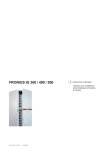
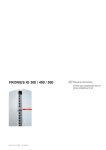
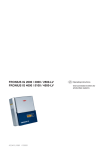
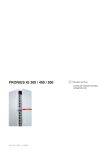
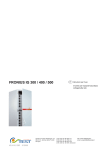
![FRONIUS IG US [42,0410,1089]](http://vs1.manualzilla.com/store/data/005774043_1-689bd6c2a055f0ab88c64924d7fd22c0-150x150.png)
